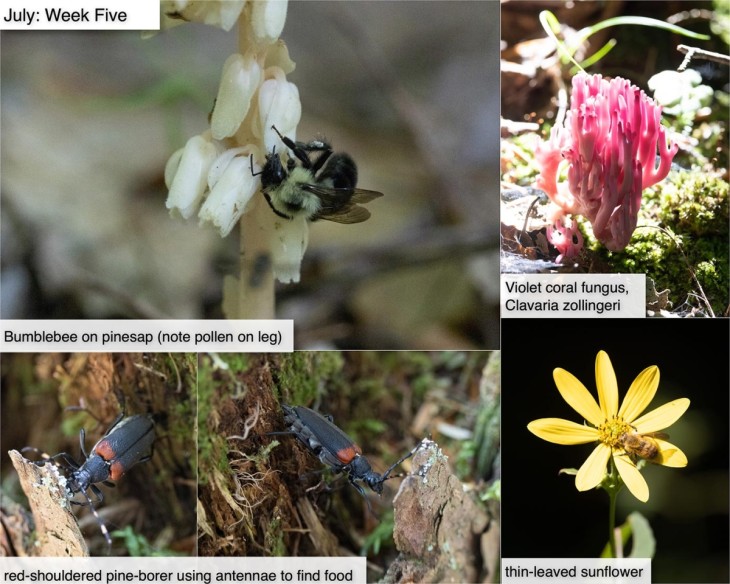This week in the woods, we’ve been seeing a lot of Monotropa in bloom – both ghost pipe and pinesap, shown here in the company of a bumble bee. Neither of these plants photosynthesize and they have a similar, waxy appearance, except that pinesap typically has multiple flowers on a stem and more color: specimens can be yellow, pale pink, or sometimes even a rich rose. To make a living, both pinesap and ghost pipe rely on their relationships with mycorrhizal fungi, which in turn draw nutrients from tree roots. Bumble bees are common pollinators of pinesap, and in the photo, you can see pinesap pollen on the bee’s leg.
We were tickled pink to find this specimen of violet coral, Clavaria zollingeri. Different lighting conditions can radically change the appearance of this species. As wind shifted boughs in the canopy above, the coral changed back and forth from Barbie pink (as shown) to pale lavender. Special thanks to mushroom expert extraordinaire Meg Madden for confirming the species. If you’d like to see her exquisite fungi photography, check her out on Instagram: @spore.stories.
Thin-leaved sunflowers, a big and beautiful late-summer aster, is blooming now in sandy, moist areas. It often grows in full sunlight, but it also seems to do well in the mostly shaded edges of forests. Wherever it blooms, the flower is almost always attended by bees and other pollinators.
Finally, we found this red-shouldered pine-borer walking on a stump, waggling its long antennae back and forth in the air. After a few minutes, it reached across a void to touch its antennae to these small growths …probably fungi, and then briefly used its antennae to support its weight as it leaned forward, secured a hold on the other side with its front legs, and began to feed. Did we channel Marlin Perkins and give a moment-to-moment narration of the beetle’s progress? Only the dog knows. Red-shouldered pine-borers are part of the flower longhorn family, so known because they often visit flowers and eat pollen and nectar (and in the process, serve as pollinators, too). Fun fact: beetles and flies don’t get much credit for pollination these days, but as noted in a blog post by the Xerces Society, they’ve been doing this work for some for 150 million years – long before bees and butterflies evolved.
What have you noticed in the woods this week? Submit a recent photo for possible inclusion in our monthly online Reader Photo Gallery.


